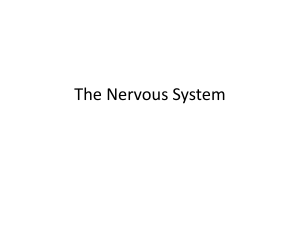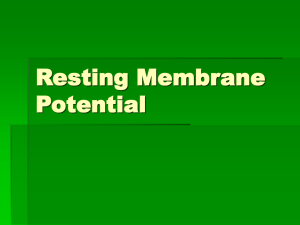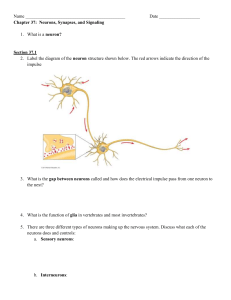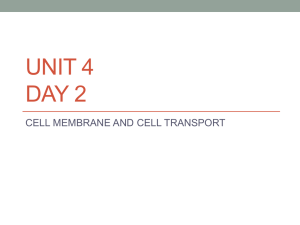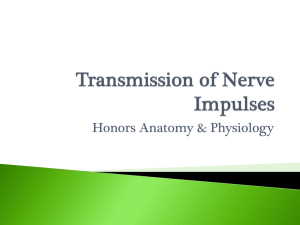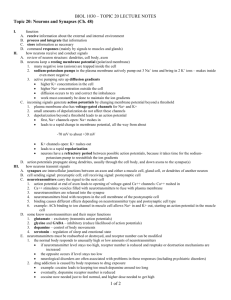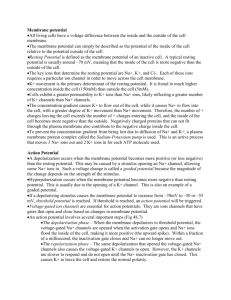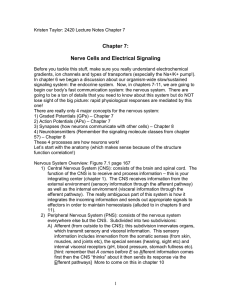Action potentials
advertisement
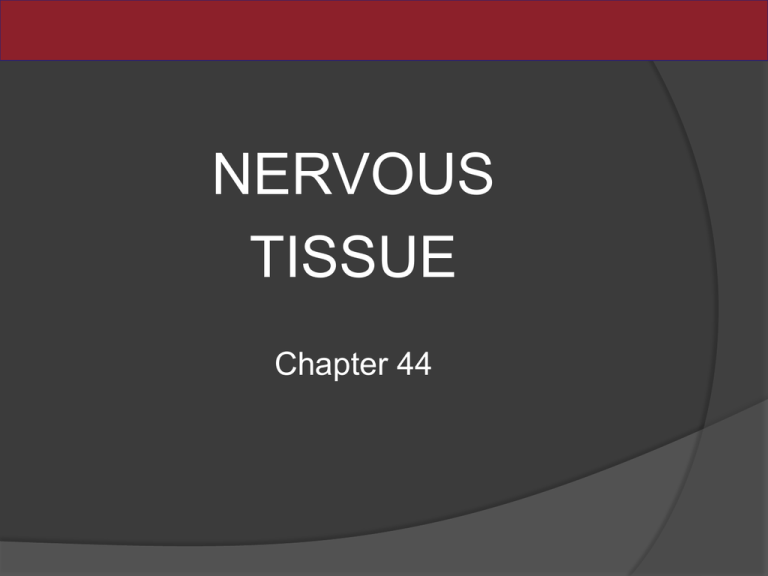
NERVOUS TISSUE Chapter 44 What Cells Are Unique to the Nervous System? Nervous systems have two categories of cells: Neurons generate and propagate electrical signals, called action potentials. Glial cells provide support and maintain extracellular environment. Neurons are organized into networks. Afferent (Sensory) neurons carry information into the system. Efferent (Motor) neurons carry commands to effectors. Interneurons store information and help with communication in the system. Figure 44.1 Nervous Systems Vary in Size and Complexity (A,B) Use Fig 44.1: A, B, and C Figure 44.1 Nervous Systems Vary in Size and Complexity (C) Central nervous system (CNS) – consists of cells found in brain and spinal cord Peripheral nervous system (PNS) – neurons and support cells found outside the CNS Figure 44.1 Nervous Systems Vary in Size and Complexity (D) Figure 44.2 Brains Vary in Size and Complexity Use Fig 44.2 Most neurons have four regions: Cell body: contains the nucleus and organelles Dendrites: bring information to the cell body Axon: carries information away from the cell body Axon terminal: forms synapse at tip of axon Figure 44.3 Neurons (Part 1) Use Fig 44.3: A Figure 44.3 Neurons (Part 2) Use Fig 44.3: B Glial cells, or glia, outnumber neurons in the human brain. Glia do not transmit electrical signals but have several functions: Support during development Supply nutrients Maintain extracellular environment Insulate axons Figure 44.4 Wrapping Up an Axon Use Fig 44.4, could use just A How Do Neurons Generate and Conduct Signals? Action potentials are the result of ions moving across the plasma membrane. Ions move according to differences in concentration gradients and electrical charge. Membrane potential is the electric potential across the membrane. Resting potential is the membrane potential of a resting neuron. Voltage causes electric current as ions to move across cell membranes. Major ions in neurons: Sodium (Na+) Potassium (K+) Calcium (Ca2+) Chloride (Cl–) The inside of the cell is negative at rest. An action potential allows positive ions to flow in briefly, making the inside of the cell more positive. The plasma membrane contains ion channels and ion pumps that create the resting and action potentials. The sodium–potassium pump uses ATP to move Na+ ions from inside the cell and exchanges them for K+ from outside the cell. This establishes concentration gradients for Na+ and K+. Figure 44.6 Ion Pumps and Channels (Part 1) Figure 44.6 Ion Pumps and Channels (Part 2) Ion channels in the membrane are selective and allow some ions to pass more easily. The direction and size of the movement of ions depends on the concentration gradient and the voltage difference of the membrane. These two forces acting on an ion are its electrochemical gradient. Potassium channels are open in the resting membrane and are highly permeable to K+ ions. K+ ions diffuse out of the cell along the concentration gradient and leave behind negative charges within the cell. K+ ions diffuse back into the cell because of the negative electrical potential. Some ion channels are gated, and open and close under certain conditions. Voltage-gated channels respond to a change in the voltage across the membrane. Chemically-gated channels depend on molecules that bind or alter the channel protein. Mechanically-gated channels respond to force applied to the membrane. Gated ion channels change the resting potential when they open and close. The membrane is depolarized when Na+ enters the cell and the inside of the neuron becomes less negative than when at rest. If gated K+ channels open and K+ leaves, the cell becomes more negative inside and the membrane is hyperpolarized. Figure 44.9 Membranes Can Be Depolarized or Hyperpolarized (Part 1) Figure 44.9 Membranes Can Be Depolarized or Hyperpolarized (Part 2) Figure 44.9 Membranes Can Be Depolarized or Hyperpolarized (Part 3) Action potentials are sudden, large changes in membrane potential. Voltage-gated Na+ and K+ channels are responsible for action potentials. If a cell body is depolarized, voltage-gated Na+ channels open and Na+ rushes into the axon. The influx of positive ions causes more depolarization. A threshold is reached at 5–10 mV above resting potential.The influx of Na+ is not offset by the outward movement of K+. Many voltage-gated Na+ channels then open, the membrane potential becomes positive, and an action potential occurs. The axon returns to resting potential as voltage-gated Na+ channels close and voltage-gated K+ channels open. Figure 44.10 The Course of an Action Potential (Part 2) Figure 44.10 The Course of an Action Potential (Part 3) An action potential is an all-or-none event because voltage-gated Na+ channels have a positive feedback mechanism that ensures the maximum value of the action potential. An action potential is self-regenerating because it spreads to adjacent membrane regions. Figure 44.11 Action Potentials Travel along Axons (Part 1) Figure 44.11 Action Potentials Travel along Axons (Part 2) Figure 44.11 Action Potentials Travel along Axons (Part 3) When the positive current reaches the next node, the membrane is depolarized and another axon potential is generated. Action potentials appear to jump from node to node, a form of propagation called saltatory conduction. Figure 44.12 Saltatory Action Potentials How Do Neurons Communicate with Other Cells? Neurons communicate with other neurons or target cells at synapses. In a chemical synapse chemicals from a presynaptic cell induce changes in a postsynaptic cell. In an electrical synapse the action potential spreads directly to the postsynaptic cell. The neuromuscular junction is a chemical synapse between motor neurons and skeletal muscle cells. The motor neuron releases acetylcholine (ACh) from its axon terminals. The postsynaptic membrane of the muscle cell is the motor end plate. Figure 44.13 Chemical Synaptic Transmission Begins with the Arrival of an Action Potential



